‘In Arcadia’; ‘That was our place’
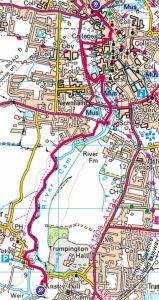 KEY DATA
KEY DATA
- Terrain: easy going
- Starting point: Trumpington Park & Ride, 43 Hauxton Rd, CB2 9FT (take the bus into the city centre first, then return here on foot from Byron’s Pool via Consort Avenue)
- Distance: 6.8 km (4.3 miles)
- Time: 1 hr 45 mins
- OS Map: OS Explorer 209. The map can also be found at: https://explore.osmaps.com/en/route/10676491/Inspiring-Places-The-River-Cam-Cambridge
- Facilities: many in Cambridge, tea rooms and pub in Grantchester
WRITERS FEATURED IN OUR WALK
Samuel Pepys (1633-1703), C.S. Lewis (1898-1963), William Wordsworth (1770-1850), Douglas Adams (1952-2001), Lord Byron (1788-1824), Vladimir Nabokov (1899-1977), Alfred Tennyson (1809-1892), Zadie Smith (1975-), David Gilmour (1946-), Ted Hughes (1930-1998), Sylvia Plath (1932-1963), Rupert Brooke (1887-1915), Geoffrey Chaucer (1340s-1400), Xu Zhimo (1897-1931)
CAMBRIDGE AS A SOURCE OF LITERARY INSPIRATION
Cambridge’s landscape has had a very mixed press over the centuries, it is after all very flat and often rather windy, they say the wind comes straight from Siberia. Wordsworth writes of ‘the wide plain o’erhung with clouds’, and Penelope Fitzgerald is astonished by the conditions: ‘How could the wind be so strong, so far inland, that cyclists coming into the town in the late afternoon looked more like sailors in peril.’
The architecture of the city itself also lacks the urban grandeur of Oxford – there are no grand streets to match Oxford’s High or ‘the stream-like windings of that glorious street,’ as Wordsworth described Broad St.
It is the Cam that is really the stand-out feature in terms of the landscape, the manicured splendour of The Backs with fabulous views of the ancient colleges, and the wilder pastoral idyll of Grantchester Meadows; crisscrossed by the passage of many punts full of happy people imbibing their Arcadian surroundings, one poor ‘designated driver’ struggling with the punt pole whilst the rest of the party are merrily drinking bubbly and eating strawberries oblivious to the fact that the punt is about to hit the bank hard. National Trust chairman Simon Jenkins has rated the view of The Backs and King’s College as one of the top ten in England.
OUR WALK
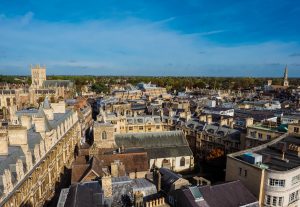 We start out from the top of the Castle Mound, just north of Magdalene College and alongside Kettle’s Yard (a great visit and caf if you have the time). This gives us the chance to get our bearings across this incredibly flat city. The sixteenth-century King’s College Chapel is straight ahead, stretched out in all its glory from east to west, whilst the 1930s brick-built University Library is to its right, gaunt, upright and the tallest building in the landscape. These two landmarks provide markers throughout our passage, a pair of architectural North stars.
We start out from the top of the Castle Mound, just north of Magdalene College and alongside Kettle’s Yard (a great visit and caf if you have the time). This gives us the chance to get our bearings across this incredibly flat city. The sixteenth-century King’s College Chapel is straight ahead, stretched out in all its glory from east to west, whilst the 1930s brick-built University Library is to its right, gaunt, upright and the tallest building in the landscape. These two landmarks provide markers throughout our passage, a pair of architectural North stars.
Magdalene
We pop into Magdalene College to visit the extraordinary Pepys Library, Samuel Pepys’ personal collection of over 3,000 volumes, which he bequeathed to his old college on condition that its contents remain intact and unaltered. We gaze in wonder at his original diaries and the bookshelves themselves that were constructed by Pepys’ dockyard joiners.
C.S. Lewis held the Chair of Medieval and Renaissance English in Magdalene in the 1950s and had a particular fondness for the college.
St John’s
Next, we cross the bridge to St John’s, where Wordsworth was an undergraduate. He described his arrival along our same route:
‘Onward we drove beneath the Castle; caught,
While crossing Magdalene Bridge, a glimpse of Cam.’
Wordsworth’s first impression of the flat fenland of Cambridge was underwhelming when compared to the majestic hills and lakes of his native Cumbria. He writes in ‘The Prelude’ of ‘the wide plain o’erhung with clouds’, and complains about his rooms, a ‘nook obscure’ above the College kitchens. He had mixed feelings about college life and expressed a preference for ‘pacing alone the level fields’.
The not so serious Douglas Adams (‘Hitchhiker’s Guide to the Galaxy’) was also at St John’s and probably had a lot more fun. ‘He had extracted himself from the Cambridge one-way system by the usual method, which involved going round and round it faster and faster until he achieved a sort of escape velocity.’
Trinity
We enter through the great Trinity gates (entrance fees apply) and walk rather self-consciously through Great Court, apparently the largest enclosed green space in the land, an uninterrupted space apart from the fountain in the middle, where many of our authors were no doubt dunked at least once. Lord Byron had his rooms here, famously shared with a pet bear.
‘I have got a new friend, the finest in the world, a tame Bear, when I bought him here, they asked me what I meant to do with him, and my reply was “he should sit for a fellowship.” This answer delighted them not, we have eternal parties here, and this evening a large assortment of Jockies, Gamblers, Boxers, Authors, parsons, and poets, sup with me. – A precious Mixture, and they go well together.’ (1807)
Vladimir Nabokov was another high-living undergraduate here in the early 1920s. In Speak Memory (1951), he writes:
‘Not once in my three years of Cambridge did I visit the University Library, or find out if there existed a College library where books might be borrowed for reading in one’s digs. I skipped lectures. I sneaked to London and elsewhere. I conducted several love affairs simultaneously.’ He later drew on his Cambridge experiences to write several works, including ‘Glory’ and ‘The Real Life of Sebastian Knight’.
We think of his lines as we go up the steps past the hall, where a few undergraduates are eating, in rather more informal garb than that he describes:
‘The University Poem’ (1926)
‘Supper. The regal dining hall
graced by the likeness of Henry the Eighth –
those tight-sheathed calves, that beard –
all by the sumptuous Holbein limned;
inside that singularly towering hall
that choir lofts made appear so tall,
it was perpetually murky
despite the violet conflagration,
that filtered through the colour panes.
The naked benches stretched along
the naked tables; there we sat,
in the black cowls of brothers’ capes,
and ate the over-seasoned soups
made out of pallid vegetables.’
A kind of Trip Advisor in verse.
We make up for Vladimir’s biblio-omissions and make the Wren Library our next stop, just across Neville Court. It is an elegant architectural construct housing an extraordinary collection, including the fourteenth-century manuscript of Piers Plowman, Sir Isaac Newton’s own annotated copy of the Principia Mathematica and the manuscript of Winnie the Pooh. We admire a full-sized statue of Lord Byron and are not surprised to learn that it was refused a spot in Poets’ Corner in Westminster Abbey due to the poet’s reputation for immorality (fully earned it would seem).
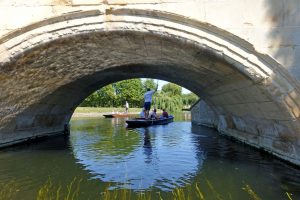 We walk back under the library and out through New Court to The Backs, noting how the name of each student is painted onto the wall by the staircase of their room.
We walk back under the library and out through New Court to The Backs, noting how the name of each student is painted onto the wall by the staircase of their room.
The first set of lime trees we pass before the bridge was planted in 1780, the very limes that Tennyson writes about in ‘In Memoriam’ (1850), commemorating his friend Arthur Hallam, another Trinity poet, who had had rooms in New Court:
‘I past beside the reverend walls
In which of old I wore the gown;
I roved at random thro’ the town,
And saw the tumult of the halls;And heard once more in college fanes
The storm their high-built organs make,
And thunder-music, rolling, shake
The prophet blazon’d on the panes;And caught once more the distant shout,
The measured pulse of racing oars
Among the willows; paced the shores
And many a bridge, and all aboutThe same gray flats again, and felt
The same, but not the same; and last
Up that long walk of limes I past
To see the rooms in which he dwelt.Another name was on the door:
I linger’d; all within was noise
Of songs, and clapping shand, and boys
That crash’d the glass and beat the floor’
King’s College
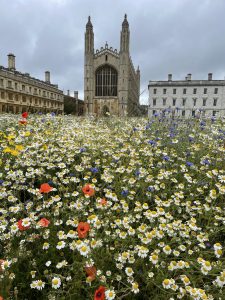 We leave Trinity by the Queen’s Rd gates and head south past Trinity Hall, Clare and then King’s, with a glorious view across the cow pasture to King’s College Chapel. William Wordsworth captures its architectural genius so well:
We leave Trinity by the Queen’s Rd gates and head south past Trinity Hall, Clare and then King’s, with a glorious view across the cow pasture to King’s College Chapel. William Wordsworth captures its architectural genius so well:
‘So deemed the man who fashioned for the sense
These lofty pillars, spread that branching roof
Self-poised, and scooped into ten thousand cells,
Where light and shade repose, where music dwells
Lingering—and wandering on as loth to die;
Like thoughts whose very sweetness yieldeth proof
That they were born for immortality.’
King’s has been blessed with many writers, especially in the twentieth century, including Rupert Brooke, EM Forster (his novel ‘Maurice’ is set here), Salman Rushdie and Zadie Smith, who commented about her time here; ‘Cambridge was a joy. Tediously. People reading books in a posh place. It was my fantasy. I loved it. I miss it still.’ Perhaps not surprisingly it has also done very well with contemporary composers, including Judith Weir, Thomas Adès and George Benjamin.
Grantchester Meadows
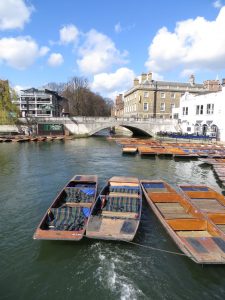
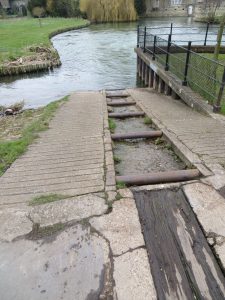 We head over Queen’s Bridge and past the rollers that take the punts around the weir from one level of the Cam to another. This next stretch along to Grantchester Meadows makes for a glorious walk. As a pair of geese take off honking from the river, we are reminded that Pink Floyd band member David Gilmour lived nearby at 109 Grantchester Meadows in the 1950s, and this stretch of river was the inspiration for his song ‘Grantchester Meadows’, starring a honking goose and a skylark. The lyrics describe a pastoral and dream-like scene on the Meadows, which is exactly how we feel on this beautiful early summer’s day:
We head over Queen’s Bridge and past the rollers that take the punts around the weir from one level of the Cam to another. This next stretch along to Grantchester Meadows makes for a glorious walk. As a pair of geese take off honking from the river, we are reminded that Pink Floyd band member David Gilmour lived nearby at 109 Grantchester Meadows in the 1950s, and this stretch of river was the inspiration for his song ‘Grantchester Meadows’, starring a honking goose and a skylark. The lyrics describe a pastoral and dream-like scene on the Meadows, which is exactly how we feel on this beautiful early summer’s day:
“In the lazy water meadow I lay me down.
All around me, Golden sunflakes settle on the ground,
Basking in the sunshine of a by gone afternoon, Bringing sounds of yesterday into this city room. “
David Gilmour may well have seen a loving couple talking to the cows, for this was also a favourite spot of Ted Hughes and Sylvia Plath, who would wander here together at unusual hours (they lived in nearby 55 Eltisley Avenue when they were newlyweds in 1956).
Sylvia wrote in a letter to her mother: “Got up at 4.30 a.m. this day with Ted and went for a long walk to Grantchester … I felt a peace and joy in the most beautiful world with animals and birds … We began mooing at a pasture of cows, and they all looked up, and as if hypnotised, began to follow us in a crowd of about twenty across the pasture to a wooden stile, staring fascinated. I stood on the stile and, in a resonant voice, recited all I knew of Chaucer’s Canterbury Tales for about twenty minutes. I never had such an intelligent, fascinated audience”. Today, the cows are totally indifferent to us, whatever we recite.
An unpublished Ted Hughes poem beautifully describes this spot and its importance to him:
‘Cambridge was our courtship.
Not the colleges, or such precincts,
But everything from the Millbridge
Towards Grantchester.
Ornamented with willows, and green level,
Full drooping willows and rushes, and mallard and swans,
Or stumpy pollard willows and the dank silence
Of the slippery lapsing Cam. That was our place.’
Rupert Brooke moved to Grantchester in 1911 when he became fed up with King’s, the halcyon experience immortalised in his most famous poem, ‘The Old Vicarage, Grantchester.’
‘I only know that you may lie
Day long and watch the Cambridge sky,
And, flower-lulled in sleepy grass,
Hear the cool lapse of hours pass,
Until the centuries blend and blur
In Grantchester, in Grantchester
Still in the dawnlit waters cool’…
‘…Say, is there Beauty yet to find?
And Certainty? and Quiet kind?
Deep meadows yet, for to forget
The lies, and truths, and pain? . . . oh! yet
Stands the Church clock at ten to three?
And is there honey still for tea?’
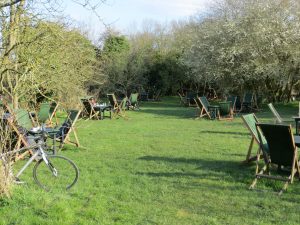 Rupert Brooke was very fond of tea, and he used to get his mates together at the Orchard Tea Rooms, where we stop for tea today, much the same as it would have been in his time, with ramshackle deckchairs and an air of nostalgia under the apple trees. If we had passed through a century or so ago, we might have found ourselves sitting next to the ‘Grantchester Group’, comprising Rupert Brooke, EM Forster, Virginia Woolf, Bertrand Russell, Augustus John, Maynard Keynes and Ludwig Wittgenstein. They spent their days in animated discourse and enjoying the nature around them (‘in Arcadia’, as Brooke described it). Today the groups of undergraduates seem just as animated, but not yet so famous. Peruse the list of famous figures who have had tea here – www.theorchardteagarden.co.uk/famous-visitors
Rupert Brooke was very fond of tea, and he used to get his mates together at the Orchard Tea Rooms, where we stop for tea today, much the same as it would have been in his time, with ramshackle deckchairs and an air of nostalgia under the apple trees. If we had passed through a century or so ago, we might have found ourselves sitting next to the ‘Grantchester Group’, comprising Rupert Brooke, EM Forster, Virginia Woolf, Bertrand Russell, Augustus John, Maynard Keynes and Ludwig Wittgenstein. They spent their days in animated discourse and enjoying the nature around them (‘in Arcadia’, as Brooke described it). Today the groups of undergraduates seem just as animated, but not yet so famous. Peruse the list of famous figures who have had tea here – www.theorchardteagarden.co.uk/famous-visitors
We turn left out of the car park into Mill Way. A few hundred yards to our right is the church, made famous in recent years by the ITV series ‘Grantchester’, which was set here.
We follow the pavement past The Old Vicarage where we see the statue of Rupert Brooke through the gate, commemorating the fact that he had lodged here.
He wrote of it: ‘This is a lonely, dank, ruined, overgrown, gloomy, lovely house: with a garden to match. It is all five hundred years old and fusty with the ghosts of generations of mouldering clergymen. It is a fit place to write my kind of poetry in.’
In more recent years it has been the home of the novelist Jeffrey Archer and his family.
We continue past the millpond heading out of the village, until we reach the sign for Byron’s Pool, just after the bridge over the Cam.
As we head off the road along a path, we spy an old mill pond on our left in the bushes; this spot, called Old Mill Holt, is believed to be where Trumpington Mill was, the setting for Chaucer’s Reeve’s Tale:
‘At TRUMPYNGTOUN, nat fer fro Cantebrigge,
Ther gooth a brook, and over that a brigge,
Upon the whiche brook ther stant a melle;
And this is verray sooth that I yow telle.
A millere was ther dwellynge many a day’.
The tale is about two students who are cheated out of part of their meal by the miller Symkyn, and revenge themselves on him by going to bed with his wife and daughter.
Wordsworth admired it too: ‘Beside the pleasant Mill of Trompington/I laughed with Chaucer in the hawthorn shade’. Sadly, there is no sign of the mill today, but the millpond is still here, and there is certainly some hawthorn shade.
Byron’s Pool itself is a little further upstream. This was the spot where Lord Byron and his group of friends regularly took a swim (we know not if the bear came too).
Here you have a choice of ways home:
- Retrace your steps, taking the footpath opposite Grantchester’s church this time, back across the meadows
- Head onto the High St in Trumpington via Consort Avenue and catch a bus back into the centre of Cambridge (Trumpington Park & Ride)
- If you have an insatiable appetite for a circular walk, head back towards Cambridge along the High St. Take the right road along Long Road and take Hobson’s Conduit/Vicar’s Brook footpath to the left before the bridge over the Busway; this is an absolutely charming route that takes you past the Botanic Garden (a big inspiration for Charles Darwin). Hobson’s Conduit was built in 1610 to bring fresh water into the centre of Cambridge. Hobson’s claim to everlasting fame is the phrase ‘Hobson’s Choice’, which of course means no real choice at all. He kept a stable of horses which he would hire out in strict rotation, the customer having to accept whichever horse he was offered, or none at all! Hence the phrase was born.
As we leave the Cam behind us, Xu Zhimo’s Chinese poem comes to mind, which has drawn myriad tourists to Cambridge since its 1928 publication – it is a beautiful fond farewell:
Quietly now I leave the Cam,
As quietly as I came.
Gently wave farewell the clouded
Western sky aflame…
OTHER STUFF
- Visit: Pepys Library, Magdalene. Limited opening times, www.magd.cam.ac.uk/pepys/visiting
- Visit: Wren Library, Trinity. Limited opening times, www.trin.cam.ac.uk/about/public-opening-hours/
- Visit: Heffers, 20 Trinity St, CB2 1TY, although it seems a bit tired these days and the layout keeps changing. Francis Spufford wrote about it: ‘If your memory was OK you could descend upon a bookshop – a big enough one so that the staff wouldn’t hassle a browser – and steal the contents of books by reading them. I drank down 1984 while loitering in the ‘O’ section of the giant Heffers store.’
- Browse: Secondhand bookshops, including David’s Bookshop, 16 St Edward’s Passage, CB2 3PJ. As well as two rooms of bargain books it has a large collection of antiquarian books, maps and engravings. The Haunted Bookshop, 9 St Edward’s Passage, Cambridge CB2 3PJ. A higgledy-piggledy crooked house crammed with illustrated children’s titles.
- Visit during: Cambridge’s Literary Festival. Held twice a year, in April & November. www.cambridgeliteraryfestival.com
- Sign Up: for A Literary Cambridge Tour at www.inkandstones.co.uk/
- Visit: The Fitzwilliam Museum – look at manuscripts from Keats and Rupert Brooke’s ‘The Old Vicarage, Grantchester’.


Leave a Reply